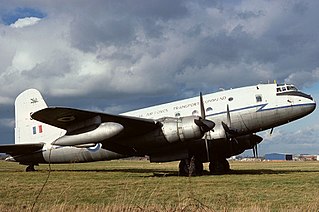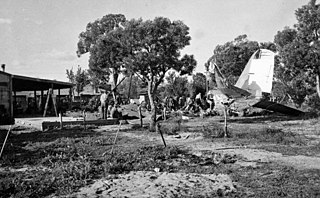Air Union was a French airline established on 1 January 1923, as the result of a merger between the airlines Compagnie des Messageries Aériennes and Compagnie des Grands Express Aériens. Air Union was merged with four other French airlines to become Air France on 7 October 1933.

The Little Baldon air crash occurred on 6 July 1965 when a Handley Page Hastings C1A transport aircraft operated by No. 36 Squadron Royal Air Force, registration TG577, crashed into a field in Little Baldon, near Chiselhampton, Oxfordshire, shortly after taking off from RAF Abingdon. The flight was captained by Flt Lt John Akin. All 41 people aboard, including six crew, perished in the crash, making it the third worst air crash in the United Kingdom at the time.

The October 1926 Air Union Blériot 155 crash happened on 2 October 1926 at Leigh, Kent when Blériot 155 F-AICQ caught fire in mid-air and crashed while the pilot attempted to make an emergency landing at Penshurst Airfield. Both crew members and all five passengers were killed. This was the first in-flight fire occurring on an airliner.

The August 1926 Air Union Blériot 155 crash happened on 18 August 1926 at Hurst, Kent when Blériot 155 F-AIEB of Air Union hit a barn and crashed whilst attempting to make a forced landing in bad weather. Two passengers were killed in the accident, and the pilot died a day later.

The 1930 Air Union Farman Goliath crash occurred on 10 February 1930 when a Farman F.63 Goliath of Air Union crashed whilst attempting an emergency landing at Marden Airfield, Kent following the failure of the starboard tailplane. Two of the six people on board were killed.
The 1947 Croydon Dakota accident occurred on 25 January 1947 when a Spencer Airways Douglas C-47A Skytrain (Dakota) failed to get airborne from Croydon Airport near London, and crashed into a parked and empty ČSA Douglas C-47 destroying both aircraft and killing 11 passengers and one crew member.

The 1934 Hillman's Airways de Havilland Dragon Rapide crash occurred on 2 October 1934 when a de Havilland DH.89A Dragon Rapide of Hillman's Airways crashed into the English Channel off Folkestone, Kent, killing all seven people on board. The aircraft was operating an international scheduled passenger flight from Abridge Aerodrome to Le Bourget Airport, Paris. The accident resulted in the first write-off of a Dragon Rapide.

The 1929 Imperial Airways Handley Page W.10 crash happened on 17 June 1929 when Handley Page W.10 G-EBMT suffered an engine failure and subsequently ditched in the English Channel off Dungeness with the loss of seven lives. The aircraft was operating an international scheduled flight from Croydon to Le Bourget Airport, Paris, France.

Two Air France Douglas DC-4 aircraft crashed two days apart in June 1950 within a few miles of each other and under similar circumstances. These two accidents, on 12 and 14 June, occurred while the aircraft were operating the same route from Saigon to Paris. Both aircraft had stopped at Karachi Airport and crashed into the sea on approach to Bahrain. A total of 86 passengers and crew were killed: 46 on June 12 and 40 on June 14. There were a total of 19 survivors: 6 on June 12 and 13 on June 14.

The 1947 BOAC Douglas C-47 Crash occurred on 11 January 1947 when Douglas C-47A G-AGJX of British Overseas Airways Corporation (BOAC) crashed into a hill at Stowting, Kent, in southeast England, killing five people outright, with a further three dying from injuries received. The aircraft had been operating a scheduled international flight to West Africa via France. Poor weather caused the aircraft to attempt to divert. After attempts to land at a number of French airports, the pilot decided to return to the United Kingdom as he was running short of fuel. The aircraft crashed while attempting to land at Lympne Airport.
The 1935 SABENA Savoia-Marchetti S.73 crash occurred on 10 December 1935 when Savoia-Marchetti S.73 OO-AGN of Belgian airline SABENA crashed at Tatsfield, Surrey, England, while on an international scheduled flight from Brussels Airport Haren, Belgium to Croydon Airport, United Kingdom. All eleven passengers and crew were killed.

The 1929 Luft Hansa Junkers G.24 crash occurred on 6 November 1929 when a Junkers G 24 of Luft Hansa crashed at Godstone, Surrey, United Kingdom while on an international scheduled flight from Croydon, Surrey, United Kingdom to Amsterdam-Schiphol Municipal Airport, Amsterdam, Netherlands. Of the eight people on board, Glen Kidston was the only survivor.

The August 1923 Air Union Farman Goliath crash occurred on 27 August 1923 when a Farman F.60 Goliath of Air Union crashed at East Malling, Kent, United Kingdom following an engine failure and reported panic amongst the passengers. One person was killed and nine were injured, including celebrated French actor Jean Murat.

The 1923 Daimler Airway de Havilland DH.34 crash occurred on 14 September 1923 when a de Havilland DH.34 of Daimler Airway operating a scheduled domestic passenger flight from Croydon to Manchester crashed at Ivinghoe, Buckinghamshire, England, killing all five people on board.

The 1924 Imperial Airways de Havilland DH.34 crash occurred on 24 December 1924 when de Havilland DH.34 G-EBBX of Imperial Airways crashed at Purley, Surrey, United Kingdom killing all eight people on board. The aircraft was operating a scheduled international flight from Croydon, Surrey, to Paris, France. It was the first fatal accident suffered by Imperial Airways and led to the first public inquiry into a civil aviation accident in the United Kingdom. As a result of issues brought up during the inquiry, Croydon Airport was expanded, absorbing most of Beddington Aerodrome.

On 29 September 1934, an Airspeed Courier of London, Scottish & Provincial Airways Ltd crashed just north of Shoreham, Kent. The aircraft was on a scheduled international passenger flight from Heston Aerodrome west of London to Le Bourget Airport, Paris. All four people on board were killed. Two people were injured by flying débris.

On the evening of 30 November 1961, Ansett-ANA Flight 325, a service from Sydney to Canberra, Australia, operated by a Vickers Viscount 720, broke up in mid-air and crashed shortly after takeoff, when it encountered a severe thunderstorm. All 15 people on board were killed.

On 2 July 1949 a Douglas DC-3 aircraft departed from Perth, Western Australia for a night flight of 441 nautical miles (817 km) to Carnarvon. The aircraft climbed to a height of about 500 feet (150 m) and then spiralled almost vertically to the ground, killing all 18 people on board. It crashed about a mile north of Perth airport and burned for over an hour. At the time, it was the worst civil aviation accident in Western Australia.

On 10 March 1949 a Lockheed Lodestar aircraft became airborne at Coolangatta, Queensland, Australia for a flight to Brisbane. Before reaching a height of 300 feet (90 m) it suddenly pitched nose-up, stalled and crashed onto its belly beyond the end of the airstrip.














